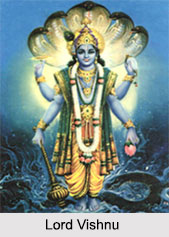 Theology of Vaishnavism has been formed on the basis of the teachings contained in the Upanishads, the Agamas, the Itihasas, the Vaishnava Puranas and the hymns of the Alvars. These various doctrines that have been propagated do not vary from the philosophical ones but in fact are the further developments of the basic philosophic concepts. They aid in meeting the needs of the religion as a way of life and as such they have assumed an added theological significance. The basic tenets that underline the theology of Vaishnavism are discussed below.
Theology of Vaishnavism has been formed on the basis of the teachings contained in the Upanishads, the Agamas, the Itihasas, the Vaishnava Puranas and the hymns of the Alvars. These various doctrines that have been propagated do not vary from the philosophical ones but in fact are the further developments of the basic philosophic concepts. They aid in meeting the needs of the religion as a way of life and as such they have assumed an added theological significance. The basic tenets that underline the theology of Vaishnavism are discussed below.
Lord Vishnu as the Ultimate Reality
In the Vaishnava religion, the Ultimate Reality of the Vedanta has been identified with a deity who is very important for the purposes of meditation and worship. Vaishnavism thus proclaims that Lord Vishnu is the Supreme deity who has been spoken of in the Rig Veda, the Upanishads, the Agamas and the Vishnu Purana. The same is known by the name of Narayana in the Upanishads, as Vasudeva in the Pancharatra Agamas and as Vishnu in the Itihasas and Puranas. The term Vishnu is defined as one who is all-pervasive. The highest Reality is called Vishnu because He pervades all the worlds, all the celestial deities, all the living beings and all the entities in the universe.
 Vishnu as Para Devata
Vishnu as Para Devata
The concept of Vishnu as the supreme Deity has acquired much significance, especially due to the inclusion of Vishnu on par with Brahma and Rudra in the popular concept of trinity (Trimurti).Historically speaking, right from the Vedic period it is an established fact that Vishnu is the highest deity. Though a number of different deities have been referred to in the Rig Veda, including Rudra and Brahma, it acknowledges the existence of one sole Reality in the name of Sat, Ekam, etc. It has been stated in the Upanishads that, the Ultimate Reality which is accepted as the material cause of the universe is to be meditated upon for attaining the spiritual goal. In fact it has also been stated in the Upanishads that at the beginning, only Narayana existed. The word Narayana is used in place of the terms sat, atman and Brahman mentioned in other passages as the cause of the universe. Even Ramanuja has said that the Brahman referred to in the Upanishads as the cause of the Universe is the same as Narayana, which is the name of the Supreme Being (Purusottama), or the Para-Tattva of the Vaishnava religion.
Thus of the various deities referred to in the Vedas, it has been established that the highest and most important is Lord Vishnu.
Vishnu in the Trinity of Gods
The Vaishnava Saints (Alvars) and the Vaishnava Acharyas; they have established conclusively the supremacy of Vishnu and the subordinate status of the other two deities. Brahma and Rudra were created by Vishnu, whereas the latter has no such origin. Philosophically, what is created cannot be eternal and cannot, therefore, become the Ultimate Reality. It is held that Brahma and Rudra were both born from Narayana and it is Narayana who had willed to create the Universe. He is, therefore, taken as the primary cause of all. Thus the three deities of the Holy trinity do not constitute one Reality and are not equal. Brahma and Rudra are not higher deities than Vishnu.
Vaishnavism therefore claims that Vishnu or Narayana is the Supreme Deity (Para-Devata). Brahma and Rudra are subordinate deities (Dasabhuti) and they carry out their major functions of creation and destruction of the universe respectively with the knowledge and power granted to them by the Supreme Being.




















